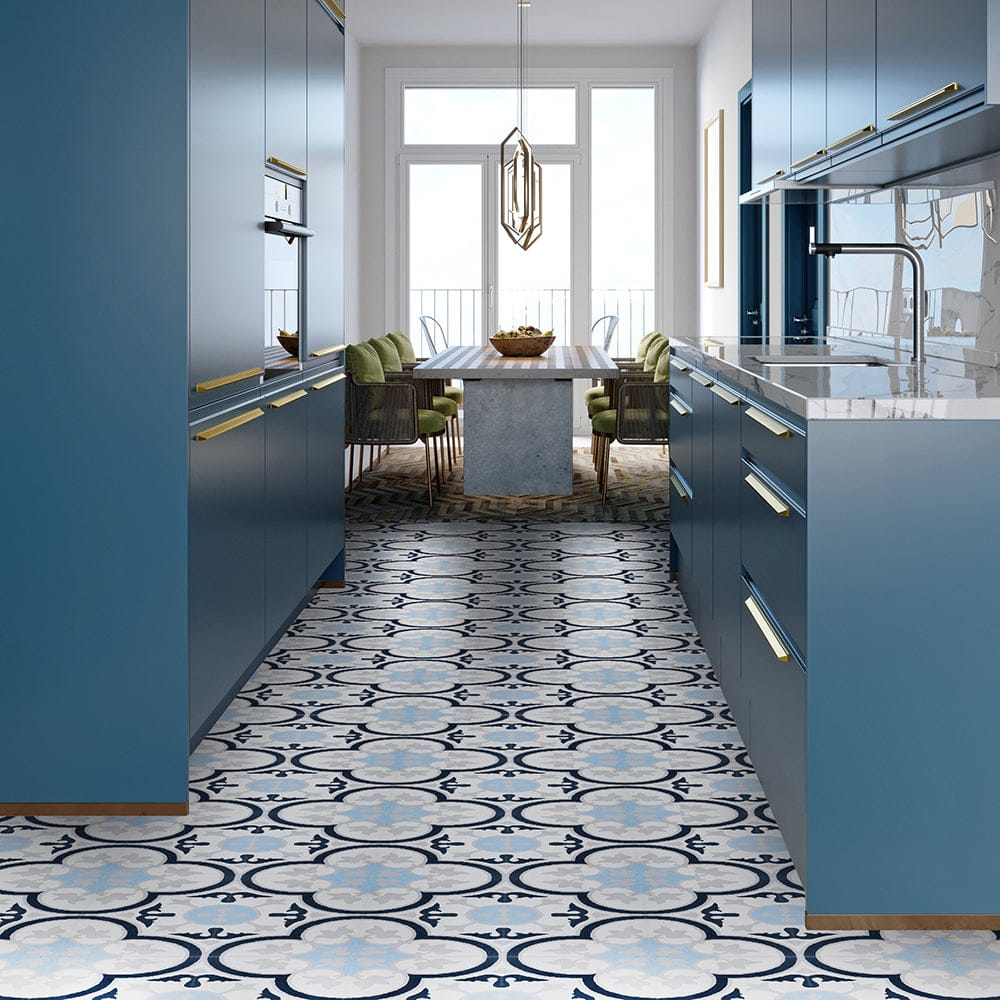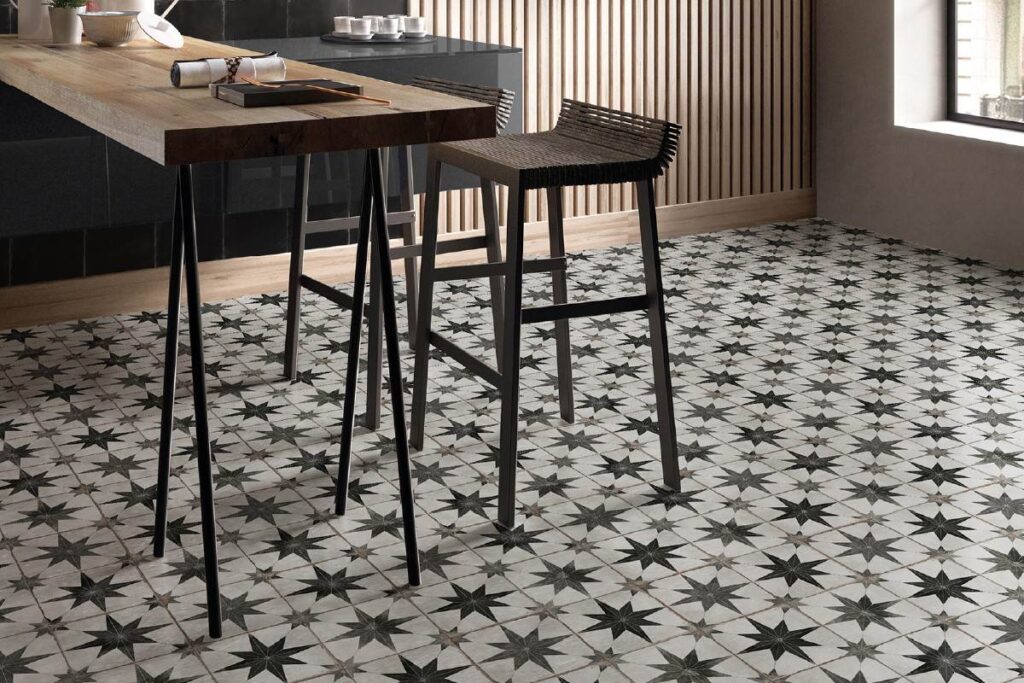Encaustic tiles have a rich, fascinating history that spans centuries, from the intricate handcraft of medieval artisans to their contemporary revival in modern design. Known for their vibrant colors, geometric patterns, and exceptional durability, these tiles are more than just building materials; they are an art form that has been revived and embraced in homes, businesses, and public spaces around the world. Let’s journey through the history of encaustic tiles, explore their ancient origins, and understand their resurgence in modern interiors today.
Origins of Encaustic Tiles
Encaustic tiles have roots that trace back to ancient Egypt, where artisans used colored clay and pigments to create decorative objects and architectural details. The term “encaustic” originates from the Greek word enkaustikos, which means “to burn in,” referring to a method of fusing patterns onto surfaces using heat. While this technique differs slightly from the modern encaustic tile-making process, it represents the enduring fascination with embedding art into building materials.
Encaustic tile-making as we know it took hold in the Middle Ages, particularly in Europe, where the process was refined by skilled craftspeople who developed intricate patterns that were then pressed and fired into clay tiles. Medieval artisans created tiles for churches and monasteries, adorning floors with religious symbols, geometric patterns, and heraldic motifs. These tiles were not only decorative but also had a functional aspect, providing durable flooring that was easy to maintain.

The Golden Age: Encaustic Tiles in Victorian England
The true golden age of encaustic tiles began in the 19th century, especially during the reign of Queen Victoria in England. Thanks to advancements in manufacturing technology, encaustic tiles experienced a surge in popularity, driven by the Victorian fascination with medieval art and Gothic architecture. British architect and designer Augustus Pugin, famous for his work on the Houses of Parliament, championed the revival of encaustic tiles as a way to connect modern Britain to its medieval past.
Manufacturers like Minton & Co. became renowned for their encaustic tile production, creating richly colored and intricately patterned tiles that adorned the floors of palaces, churches, and aristocratic homes across England and Europe. These tiles were celebrated for their artistic appeal, and they also became accessible to the middle class, allowing homeowners to introduce a touch of sophistication and grandeur to their interiors.
Encaustic Tiles Beyond Europe
The 19th-century boom in encaustic tile production soon spread beyond Europe to the United States and other parts of the world. During the Arts and Crafts movement, encaustic tiles were popularized in the U.S. as homeowners embraced handcrafted, artisan-made products that focused on quality and natural beauty. Influenced by both European and Middle Eastern design, encaustic tiles appeared in homes, public buildings, and even railroad stations across America. These tiles represented a merging of old-world craftsmanship with the new industrialized world, marking an era of decorative arts that emphasized individuality and artistic expression.
In regions like North Africa and the Middle East, encaustic tile designs drew from Islamic art traditions, incorporating geometric motifs and vibrant colors. These influences became popular in Spain and Portugal, where they evolved into what we know as Moroccan or Spanish encaustic tiles, known for their intricate, colorful patterns that are still widely appreciated today.
Decline and Dormancy
The demand for encaustic tiles began to wane in the early 20th century due to changing design trends and the introduction of cheaper, mass-produced alternatives. With the rise of Art Deco and Art Nouveau, along with the emergence of modernist styles that emphasized minimalism and functionality over decorative detail, encaustic tiles fell out of fashion. By the mid-20th century, encaustic tiles had all but disappeared from the design landscape, with production slowing to a near standstill. They became artifacts of an earlier era, preserved only in historic buildings, old churches, and heritage homes.
The Revival of Encaustic Tiles
In the 21st century, encaustic tiles have made a strong comeback as designers and homeowners have rekindled their appreciation for the artistry and uniqueness that encaustic tiles offer. This revival can be attributed to several factors:
- Interest in Artisanal and Sustainable Design
Modern consumers have shown a renewed interest in handcrafted and eco-friendly materials, appreciating the unique look and feel that mass-produced tiles cannot replicate. Encaustic tiles are often made with natural materials like cement and mineral pigments, appealing to eco-conscious buyers who want to add personality and sustainability to their spaces. - A Return to Pattern and Color
Design trends have shifted away from minimalism, with many people embracing bolder designs, richer colors, and intricate patterns that bring character to interiors. Encaustic tiles are a perfect fit for this trend, adding a vibrant and artistic element to any room. - Versatility and Modern Applications
Today’s encaustic tiles are used in both traditional and unexpected ways, from backsplashes and shower walls to stair risers and even exterior facades. Their versatility has made them popular in various applications, allowing designers to create striking spaces with a touch of vintage elegance.

Modern Manufacturing Techniques
While many artisans still craft encaustic tiles using traditional techniques, modern technology has made it possible to produce high-quality encaustic-style tiles at scale. New manufacturing processes allow for both handmade and machine-made options, giving consumers a wide range of choices in terms of price, durability, and aesthetics. Cement encaustic tiles, for example, are pressed with a hydraulic press, allowing them to be durable and weather-resistant, ideal for both indoor and outdoor applications.
Caring for Encaustic Tiles in Modern Spaces
Encaustic tiles are relatively low-maintenance but do require special care to ensure longevity. Proper sealing, gentle cleaning, and periodic resealing can keep them looking fresh and beautiful for years. Their porous nature makes them ideal for low-traffic areas, but with advancements in sealants and protective finishes, they can now be used in kitchens, bathrooms, and even outdoor patios with minimal concern.
The Future of Encaustic Tiles
Encaustic tiles are once again cherished for their ability to combine beauty, functionality, and history. With a renewed appreciation for craftsmanship and sustainable design, they’re likely to remain a beloved choice for both traditional and contemporary spaces. Modern designs incorporate both classic motifs and new, innovative patterns, blending influences from global cultures to create tiles that feel timeless yet fresh.
As interior design continues to celebrate individuality and character, encaustic tiles are perfectly suited for homeowners looking to add a touch of heritage and artistry to their spaces. Whether as a bathroom floor, a kitchen backsplash, or a statement wall, encaustic tiles are here to stay, continuing a centuries-old tradition of merging art and architecture.
Conclusion
From the grand churches of medieval Europe to contemporary homes, encaustic tiles have journeyed through time, symbolizing resilience, artistry, and a connection to the past. As they experience a new wave of popularity, encaustic tiles remind us that beauty and craftsmanship never go out of style. Their history is a testament to their enduring appeal and their ability to transform spaces, bridging ancient art with modern design in ways that remain as captivating as ever.






